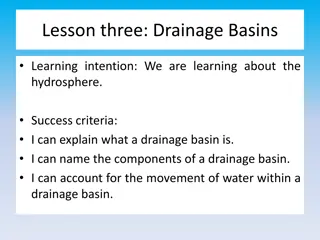Understanding Earth's Geosphere, Hydrosphere, and Biosphere
Explore the layers of the Earth, its systems, the hydrosphere including the water cycle, and the importance of Earth's oceans through informative content and images presented in this overview.
Download Presentation

Please find below an Image/Link to download the presentation.
The content on the website is provided AS IS for your information and personal use only. It may not be sold, licensed, or shared on other websites without obtaining consent from the author. Download presentation by click this link. If you encounter any issues during the download, it is possible that the publisher has removed the file from their server.
E N D
Presentation Transcript
Geosphere QUIZ Complete on the back of your quiz 1. What are the layers of the earth from outside to the inside? 2. What are the 4 systems of the earth? What does each system study/include?
Exit Ticket 1. What are the layers of the atmosphere? 2. What 2 primary gases compose the atmosphere? 3. Where in the atmosphere does weather occur? 4. Where is the ozone layer located? 5. What is the job of the ozone layer?
Chapter 3 The Dynamic Earth Section 3: The Hydrosphere and Biosphere
The Hydrosphere The hydrosphere includes all of the water on or near the Earth s surface. This includes water in the oceans, lakes, rivers, wetlands, polar ice caps, soil, rock layers beneath Earth s surface, and clouds.
The Water Cycle The water cycle is the continuous movement of water from the ocean to the atmosphere to the land and back to the ocean. Evaporation is the change of a substance from a liquid to a gas. Water continually evaporates from the Earth s oceans, lakes, streams, and soil, but the majority evaporates from the oceans.
The Water Cycle Condensation is the change of state from a gas to a liquid. Water vapor forms water droplets on dust particles, which then form clouds in which the droplets collide to create larger, heavier drops that then fall from the clouds as rain. Precipitation is any form of water that falls to the Earth s surface from the clouds, and includes rain, snow, sleet, and hail.
Earths Oceans All of the oceans are joined in a single large interconnected body of water called the world ocean. The world oceans play important roles in the regulation of the planet s environment.
Earths Oceans The largest ocean on Earth is the Pacific Ocean with a surface area of about 165,640,000 km2. The deepest point on the ocean floor, the Challenger Deep, is found in the Pacific Ocean. The Challenger Deep is located east of the Philippine islands at the bottom of the Mariana Trench and is 11,033m below sea level which is deeper than Mount Everest is tall.
Earths Oceans Oceanographers often divide the Pacific Ocean into the North Pacific and South Pacific based on the direction of the surface current flow in each half of the Pacific Ocean. Surface currents in the Pacific move in a clockwise direction north of the equator. Surface currents in the Pacific move in a counter-clockwise direction south of the equator.
Earths Oceans The second largest ocean on Earth is the Atlantic Ocean, and covers about half the area of the Pacific Ocean, which is a surface area of about 81,630,000 km2. Like the Pacific Ocean, the Atlantic Ocean can be divided into a north and south half based on the directions of surface current flow north and south of the equator.
Earths Oceans The Indian Ocean is the third largest ocean on Earth with a surface area of 73,420,000 km2. The smallest ocean is the Arctic Ocean, which covers 14,350,000 km2. The Arctic Ocean is unique because much of its surface is covered by floating ice, called pack ice, which forms when either waves or wind drive together frozen seawater, known as sea ice, into a large mass.
Hydrosphere Video Hydrosphere
Ocean Water The difference between ocean water and fresh water is that ocean water contains more salts. Salinity is a measure of the amount of dissolved salts in a given amount of liquid. Salinity is lower in places that get a lot of rain or in places where fresh water flows in to the sea. In contrast, salinity is higher where water evaporates rapidly and leaves the salts behind.
Ocean Water Most of the salt in the ocean is sodium chloride, which is made up of the elements sodium and chloride, although many other elements can be found in the ocean as well.
Bill Nye and Ocean Currents Bill Nye and Ocean Currents
Temperature Zones The surface of the ocean is warmed by the sun, while the depths of the ocean, where sunlight never reaches, are very cold, just above freezing. Surface waters are stirred up by waves and currents so the warm surface zone may be as much as 350 m deep. Below the surface zone is the thermocline, which is a layer about 300 to 700 m deep where the temperature falls rapidly.
A Global Temperature Regulator One of the most important functions of the world ocean is to absorb and store energy from sunlight which in turn regulates temperatures in Earth s atmosphere. Because the ocean both absorbs and releases heat slower than land, the temperature of the atmosphere changes more slowly. If the ocean did not regulate atmospheric and surface temperatures, temperatures would be too extreme for life to exist on Earth.
A Global Temperature Regulator Local temperatures in different areas of the planet are also regulated by the world ocean. Currents circulate warm water causing land areas they flow past to have climates that are more moderate. For example, the British Isles are warmed by the waters of the Gulf Stream.
Ocean Currents Stream like movements of water that occur at or near the surface of the ocean are called surface currents. Surface currents are wind driven and result from global wind patterns. Surface currents can be warm or cold water currents. However, currents of warm water and currents of cold water do not readily mix with one another.
Ocean Currents Deep currents are streamlike movements of water that flow very slowly along the ocean floor. Deep currents form when the cold, dense water from the poles sinks below warmer, less dense ocean water and flows toward the equator. The densest and coldest ocean water is located off the coast of Antarctica and flows very slowly northward producing a deep current called the Antarctic Bottom Water.
Fresh Water and River Systems Fresh water is water that contains insignificant amounts of salts. Most of the fresh water is locked up in icecaps and glaciers while the rest is found in places like lakes, rivers, wetlands, the soil and atmosphere. A river system is a network of streams that drains an area of land and contains all of the land drained by a river including the main river and all its smaller streams or rivers that flow into larger ones, or tributaries.
Ground water Rain and melting snow sink into the ground and run off the land. Most of this water trickles down through the ground and collects as groundwater. Although it makes up only 1 percent of all the water on Earth, groundwater fulfills the human need for fresh drinking water, and supplies agricultural and industrial need.
Aquifers A rock layer that stores and allows the flow of groundwater is called an aquifer.
The Biosphere The biosphere is the part of Earth where life exists, extending about 11 km into the ocean and about 9 km into the atmosphere. The materials that organisms require must be continually recycled. Gravity allows a planet to maintain an atmosphere and to cycle materials. Suitable combinations that organisms need to survive are found only in the biosphere.
The Biosphere The biosphere is located near Earth s surface because most of the sunlight is available near the surface. Plants need sunlight to produce their food, and almost every other organism gets its food from plants and algae. Most of the algae float at the surface of the ocean and is known as phytoplankton.
Energy Flow in the Biosphere The energy used by organisms must be obtained in the biosphere and must be constantly supplied for life to continue. When an organism dies, its body is broken down and the nutrients in it become available for use by other organisms. This flow of energy allows life on Earth to continue to exist.
Energy Flow in the Biosphere Closed systems are systems that cannot exchange matter or energy with its surroundings. Open systems are systems that can exchange both matter and energy with its surroundings. Today, the Earth is essentially a closed system with respect to matter, but an open system for energy as energy travels from plant to animal, which is eaten by other animals. In the process, some energy is lost as heat to the environment.























